Audio Technica 440MLb cartridge
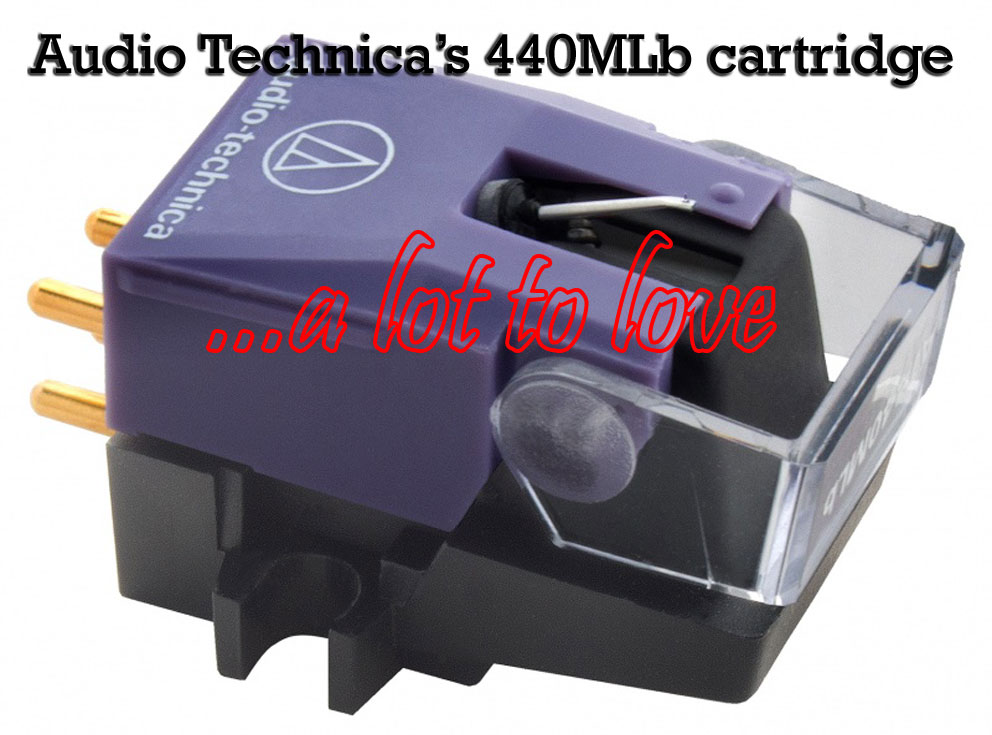
Don’t Do What I Do
 Before I expand on that age worn but worthy piece of advice, let’s take a little visit to my audio past. One day in 1974-75, while still living in my college town of Blacksburg, Va., I walked into Audio Reproduction, my first visit to a real high-end audio store, and the first place I heard true high end audio equipment. Hearing that Transcriptors turntable and the Ohm F’s powered by, I think, either Threshold or Ampzilla power amps, it was clear that audio was going to be a lifelong hobby of mine.
Before I expand on that age worn but worthy piece of advice, let’s take a little visit to my audio past. One day in 1974-75, while still living in my college town of Blacksburg, Va., I walked into Audio Reproduction, my first visit to a real high-end audio store, and the first place I heard true high end audio equipment. Hearing that Transcriptors turntable and the Ohm F’s powered by, I think, either Threshold or Ampzilla power amps, it was clear that audio was going to be a lifelong hobby of mine.
My first system from the store was a mash up of affordable components but nothing to revisit. My next upgrade was far more refined for the time. Two things stand out today: 1) I still own my first db systems db-6AM power amp (adding another 11 years later) and 2), while lusting for tube sound I traded in my db-1b preamp (for a whopping $100 credit) toward my Conrad Johnson PV-5 preamp. That deal always haunted me. I often wondered whether the db-1b was as good as I recalled it to be and re-purchased the same era db-1b a few years ago for about the same price I paid back in 1979… at least this time I got the wooden cabinet! Fascinated with the Rabco straight-line tracking tonearm at the time, my turntable was a horrendous Harman Kardon ST-7 (don’t get me started)… what a crazy, frustrating table that was. For all it’s faults, the ST-7 did sport a sweet Ortofon MC-20, my first moving coil (it’s cantilever has collapsed, but I still have it). My records from those days are still in great condition thanks to the ST-7’s unpredictable nature. I’d fight to get an album transferred to tape and used my Revox A-77 half track reel to reel as my primary source. The take away here was that this system, warts and all, was my introduction to moving coil cartridges – and, except for a recent purchase of an Ortofon 2M Red I’ve only used moving coil cartridges. Once they developed a problem, you’d traded in for a ’retipping’ discount on a new one. With no stylus replacement as with MM cartridges, MC’s were more expensive, yes, but I didn’t feel the need to stick with a moving magnet of poor choice very long, by merely replacing its stylus.
Fast forward to the recent demise of my original Sumiko Blue Point high output moving coil that served as a backup. CP suggested I reach out to Frank Doris, Audio Technica’s PR guy, and see if I could get a moderately priced cartridge to review. Doris arranged the delivery of an AT 440MLa. Once it arrived, I mounted it and worked quickly to break it in. Shortly after it’s arrival, Doris told me he had heard I might be getting the new soon to be released 440MLb and asked that I hold off on mounting the 440MLa if at all possible. Too late. As the 440MLa approached 8 hours of break-in, an issue developed due to my set up on a table and I returned the 440MLa.
Do What I Say
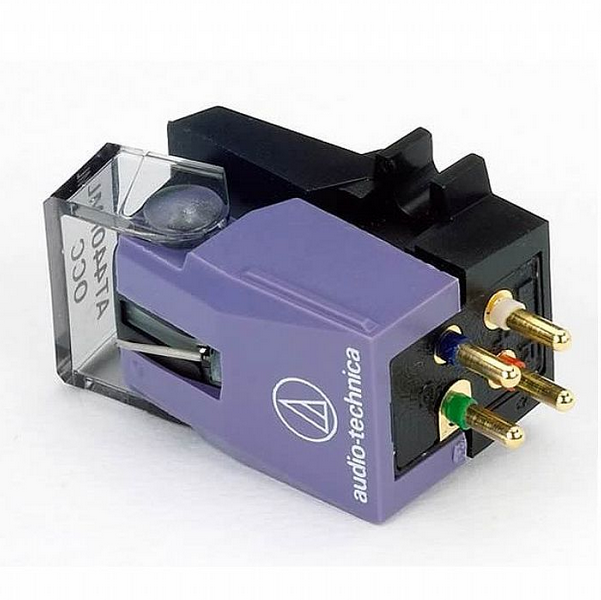 Okay. Here’s where I explain the ‘Don’t do what I do, do what I say’ quote. The Audio Technica 440MLb arrived and I carefully mounted it on my recently refurbished ‘sold for parts’ (Transparent era) Well Tempered Record Player. I knew the tracking force needed to be 1.4g-1.7g, with 1.4g being optimal. I used long plastic screws which reached nearly to the body’s bottom and, because the cartridge has open slots on either side of it’s body, was able to push the cartridge up between the screws and add the plastic nuts. No problem, at least until I removed the cartridge to move it to a different table. Here’s where it would have paid to read the instructions more closely, the ‘Do what I say’ part of this exercise. In all too small type AT recommends installing both the 440MLa and 440MLb with the screws inserted from the bottom up. Displaying such a warning in larger and bolder type would be welcomed. I searched 440MLa set up on the internet and found but one post suggesting such an install with the screws feeding upward and it wasn’t attributed to AT’s recommended set up instructions. Please read instructions, folks.
Okay. Here’s where I explain the ‘Don’t do what I do, do what I say’ quote. The Audio Technica 440MLb arrived and I carefully mounted it on my recently refurbished ‘sold for parts’ (Transparent era) Well Tempered Record Player. I knew the tracking force needed to be 1.4g-1.7g, with 1.4g being optimal. I used long plastic screws which reached nearly to the body’s bottom and, because the cartridge has open slots on either side of it’s body, was able to push the cartridge up between the screws and add the plastic nuts. No problem, at least until I removed the cartridge to move it to a different table. Here’s where it would have paid to read the instructions more closely, the ‘Do what I say’ part of this exercise. In all too small type AT recommends installing both the 440MLa and 440MLb with the screws inserted from the bottom up. Displaying such a warning in larger and bolder type would be welcomed. I searched 440MLa set up on the internet and found but one post suggesting such an install with the screws feeding upward and it wasn’t attributed to AT’s recommended set up instructions. Please read instructions, folks.
I’ve never installed a cartridge with the nuts on top of a headshell, ever. Hate the look, but I do understand that it’s easier to install a cartridge in this manner, especially for those unaccustomed to cartridge mounting. Whether it was a fluke or my mistake mounting from the top which caused the stylus housing to pivot off the back of the bottom when I tried to flip up the stylus guard, only the people at Audio Technica will truly know for sure… the 440MLb was returned. Either way, I’m eating crow. The 440MLb was nearly broken in and nearly ready for review when the mishap occurred. Unfazed, the nice folks at Audio Technica sent me another pre-production model of the 440MLb with which to continue my review.
The Audio Technica 440MLb is a dual moving magnet design with a delicate 0.12 mil nude square Micro-Linear stylus mounted on a tapered alloy cantilever tube. It’s a very light-tracking cartridge, with an optimal tracking weight of 1.4g and a tracking force range from 1.0g to 1.8g and an output voltage of 4.0 (mV at 1 kHz, 5 cm/sec). Quoting the manufacturer here, ‘the AT440MLB also features Audio-Technica’s unique Paratoroidal Signal Generator. This unique signal generating system is composed of a unified, laminated coil core wound with a single piece of wire. Internal mechanical and electrical connections are eliminated, minimizing magnetic losses and ensuring better signal transfer.’ Tracking the 440MLb at 1.427g, I noticed some mint and flat albums skipping every so often but found this to be an error due to rushing the setup – it was in no way a fault of the cartridge and disappeared with better set up.
Listening
With all settings correct, cartridge properly installed and broken in on my Well Tempered Record Player with it’s custom Audio Advancements DC thread-belt motor and through my main rig, I started listening in earnest to the sound of the 440MLb. Curious to see how the cartridge would track an extremely dense and dynamic classical work, it was time for a warhorse. I cued up Malcolm Frager’s performance of Prokofiev’s Concerto #2, a Classic Records re-issue. The Audio Technica handled the record extremely well, with all dynamics intact, with no skips and no noticeable errors.
Terje Rypdal’s ‘Blue’ (ECM Records), the 440MLb provided full bass, crisp transients and wide dynamics, handling dense musical passages with ease while presenting very good imaging and depth to the soundstage.
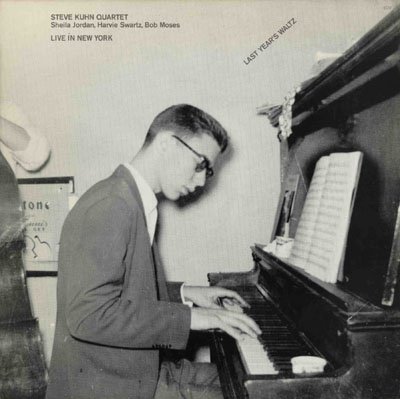 Next up, the Steve Kuhn Quartet’s ‘Last Year’s Waltz,’ recorded live at Fat Tuesdays in New York City during April, 1981 (ECM Records) was presented with nice dynamic range and separation. This LP is highly percussive with great depth and imaging. The drums are big, wide and explosive and the 440MLb did a very good job translating these attributes. During play of ’The Drinking Song,’ there is terrific and dynamic trio interplay, with the 440MLb providing the lowest lows and a nice full upper register, all forming an entertaining and energetic soundstage. Percussive textures abound through out this exciting live track, with a lot of sparkle and band member mastery moving this track forward. ‘I Remember You’ is delivered in a punchy, foot-tapping and very entertaining way. The drums are particularly special here, with their great textures and dynamics, in an exhilarating 0-60 romp driven by both the drums and flights of Kuhn’s keyboard virtuosity and dexterity. Again, the 440MLb kept up nicely.
Next up, the Steve Kuhn Quartet’s ‘Last Year’s Waltz,’ recorded live at Fat Tuesdays in New York City during April, 1981 (ECM Records) was presented with nice dynamic range and separation. This LP is highly percussive with great depth and imaging. The drums are big, wide and explosive and the 440MLb did a very good job translating these attributes. During play of ’The Drinking Song,’ there is terrific and dynamic trio interplay, with the 440MLb providing the lowest lows and a nice full upper register, all forming an entertaining and energetic soundstage. Percussive textures abound through out this exciting live track, with a lot of sparkle and band member mastery moving this track forward. ‘I Remember You’ is delivered in a punchy, foot-tapping and very entertaining way. The drums are particularly special here, with their great textures and dynamics, in an exhilarating 0-60 romp driven by both the drums and flights of Kuhn’s keyboard virtuosity and dexterity. Again, the 440MLb kept up nicely.
 Roger Waters ‘Amused To Death’ reissue on 200g vinyl from Acoustic Sounds and QRP was an event. I played the first two sides with the Benz Glider for comparison and the remaining two with the 440MLb. Transversing Side C, the 440MLb provided awe-inspiring bass and soundstage with great depth and pinpoint imaging. The vocal with the 440MLb was flatter across the front plane that with my Benz Glider, the Glider providing a bit more depth to the stage. As expected, since the Benz was roughly 3 times the price of the Audio Technica.
Roger Waters ‘Amused To Death’ reissue on 200g vinyl from Acoustic Sounds and QRP was an event. I played the first two sides with the Benz Glider for comparison and the remaining two with the 440MLb. Transversing Side C, the 440MLb provided awe-inspiring bass and soundstage with great depth and pinpoint imaging. The vocal with the 440MLb was flatter across the front plane that with my Benz Glider, the Glider providing a bit more depth to the stage. As expected, since the Benz was roughly 3 times the price of the Audio Technica.
During ‘Watching TV’ the bass is powerful and the content is very musical with an engaging soundstage more between the speakers than beyond, when compared to the Glider’s rendering. Background sounds are a touch harder to disseminate and just a touch crisp. The image has, again, less dimension when compared to that provided by the Benz Glider but the 440MLb conveys a great deal of musicality and fun.
The next section ‘Three Wishes’ showed more depth to the rear of the stage, with a nice roundness to the cymbals and nice movement to the bass in low level responses in the ‘Genie’ voice. Overall, the 440MLb provided a very pleasing frequency response – not at all tizzy, uncontrolled or hard in the upper frequencies. It’s true that voices are pushed just a bit forward and flatten a bit, but the 440MLb handles quick transients well and really digs in for the bass in the grooves.
In playing Side D, surface noise was more noticeable (this is a new LP set) than with the Glider on the Well Tempered Turntable. During ‘It’s A Miracle,’ Water’s voice was again more frontal, but instrumentation was very nice, with sharp drum transients and dynamics of notable depth. The bass guitar wafted about and reached quite low and was nicely controlled. The low drums were bold and forceful and the guitar and choir had a bit of a bright edge, perhaps, giving a touch too much attention. After the low TV noises, the low fuzz bass moved back to the middle of the stage with solid dimensionality.
Finally, the 440MLb played the final track ’Amused To Death’ very well, with it’s low dialog, nice leading transients in the guitar plucks and with great stability to the image. There was good body to the vocals and an increase to the soundstage as the instruments came in. All in all, a very nice presentation.
On Jerome Sabbagh’s ‘The Turn’ limited Kicksterter set (LP set 271 of 500) there were clear delineations in both tone and texture. The sax was warm and the cymbals had nice depth and tone. The bass nicely anchored the quartet without becoming boomy or bloated and there was a crisp edge to Ben Monder’s guitar solo, gone when he’s not soloing and well back in the mix. There was tremendous separation throughout this set. The sax had a raspy, slightly lean tone that was still meaty, with a crisp, but not cold, texture and depth that was very pleasing.
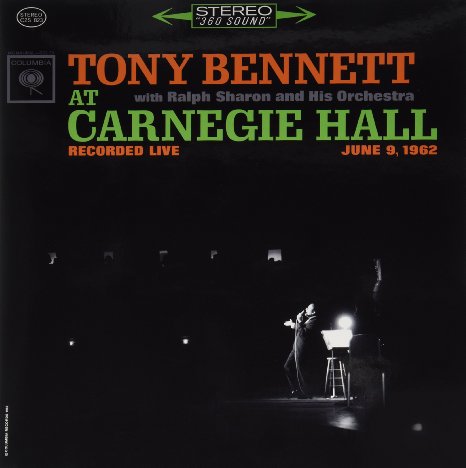 Tony Bennett’s ‘Live At Carnegie Hall’ the 1962 Columbia Records re-issued in 2014 by Acoustic Sounds and pressed at QRP on 200 gram vinyl was up next. Tony was in top form for this 1962 release. The recording was mic’d rather farther back – one can sense the volume of the hall itself. The 440MLb did a nice job in presenting a great soundstage, wide and very deep. These are all great songs, well presented and sung in front of a large band that’s spread out behind and along both sides of Bennett. The vibes have an extraordinary omni-directional presence, the stand-up bass has plenty of wood and just enough bottom end and many instruments present themselves in various songs appearing in various corners of the stage. The 440MLb delivers this large soundstage quite convincingly and with solid imaging.
Tony Bennett’s ‘Live At Carnegie Hall’ the 1962 Columbia Records re-issued in 2014 by Acoustic Sounds and pressed at QRP on 200 gram vinyl was up next. Tony was in top form for this 1962 release. The recording was mic’d rather farther back – one can sense the volume of the hall itself. The 440MLb did a nice job in presenting a great soundstage, wide and very deep. These are all great songs, well presented and sung in front of a large band that’s spread out behind and along both sides of Bennett. The vibes have an extraordinary omni-directional presence, the stand-up bass has plenty of wood and just enough bottom end and many instruments present themselves in various songs appearing in various corners of the stage. The 440MLb delivers this large soundstage quite convincingly and with solid imaging.
‘Our Love Is Here To Stay’ provided a jump factor, well-conveyed by the 440MLb, with it’s fun and bouncy bass lines. You can’t help but tap a foot to this track thanks to the cartridge’s ability to convey dynamics. The 440MLb handled Bennett’s delivery very well, with a slight upper-mid forwardness.
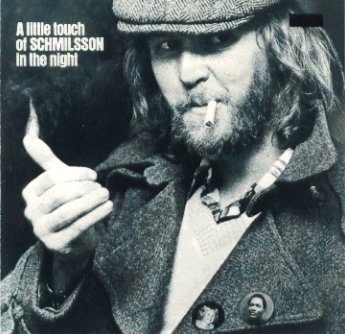 Finally, Harry Nilsson’s ‘A Little Touch of Schmilsson In The Night’ (from RCA1973) hit the platter. Though a bit worn and crackly, this LP presented Harry in fine form and with a closely mic’d bold and sonorous and large backing band. Many thought Nilsson’ voice the best rock voice in pop and rock (John Lennon, for one) at the time, and thought an album of standards a daring excursion for Harry to do. From what I’ve hard, this album may have been Harry’s favorite and it shows. There are wonderful moments – 3D flutes and soaring violin tones – and intimacy is conveyed nicely by the 440MLb. ‘Making Whoopie’ seems to be the better track here, with it’s superior vocal and very strong orchestra participation – the 440MLb dug deep into this track and brought out most of what’s in the grooves, though ever slightly glossy but with a nice bloom around the instrumentation.
Finally, Harry Nilsson’s ‘A Little Touch of Schmilsson In The Night’ (from RCA1973) hit the platter. Though a bit worn and crackly, this LP presented Harry in fine form and with a closely mic’d bold and sonorous and large backing band. Many thought Nilsson’ voice the best rock voice in pop and rock (John Lennon, for one) at the time, and thought an album of standards a daring excursion for Harry to do. From what I’ve hard, this album may have been Harry’s favorite and it shows. There are wonderful moments – 3D flutes and soaring violin tones – and intimacy is conveyed nicely by the 440MLb. ‘Making Whoopie’ seems to be the better track here, with it’s superior vocal and very strong orchestra participation – the 440MLb dug deep into this track and brought out most of what’s in the grooves, though ever slightly glossy but with a nice bloom around the instrumentation.
Final Thoughts
With the Audio Technica 440MLb cartridge, there’s a lot to love. It provides a great perspective into a performance, with it’s ability to track thru grooves with no noticeable distortion and it really digs out detail thanks to it’s micro-line profile. As my brother-in-law Tim noted, the 440MLb brings fun to vinyl listening, translating highly rhythmic passages with an ease that seems incongruous with it’s reasonable price. If there’s bounce and fun in a groove, the 440MLb delivers a great portion of it. Transient attacks were fast and tight. The 440MLb delivers bass response that was quite deep and very well controlled. While it does have a slight upper-mid and treble forwardness and does tend to flatten some vocals against the front plane a bit, the vocals still have a great body and presence about them. For those on a budget, looking for a worthy cartridge upgrade, the Audio Technica 440MLb delivers above average performance at a very reasonable price. Thanks, Audio Technica, for letting me be one of the first to hear this new pre-production cartridge!


greg voth
Specifications:
AT440MLb Dual Moving Magnet Cartridge
MSRP* US$373.00
One-Year Limited End-User Warranty
Website: www.audio-technica.com
Stereo Times Masthead
Publisher/Founder
Clement Perry
Editor
Dave Thomas
Senior Editors
Frank Alles, Mike Girardi, Russell Lichter, Terry London, Moreno Mitchell, Paul Szabady, Bill Wells, Mike Wright, and Stephen Yan,
Current Contributors
David Abramson, Tim Barrall, Dave Allison, Ron Cook, Lewis Dardick, John Hoffman, Dan Secula, Don Shaulis, Greg Simmons, Eric Teh, Greg Voth, Richard Willie, Ed Van Winkle, Rob Dockery, Richard Doran, and Daveed Turek
Site Management Clement Perry
Ad Designer: Martin Perry





Be the first to comment on: Audio Technica 440MLb cartridge